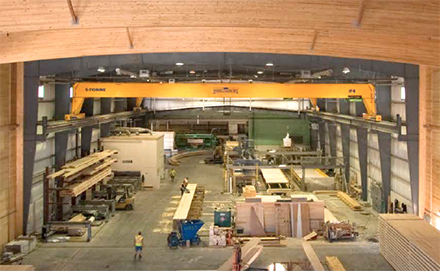In the last 25 years the wood design and construction industries have undergone great changes with the introduction of CAD and CNC robotic machines, providing this natural material with the real possibility of covering many different types of projects. The durability of wood can exceed 100 years if due care is taken in specification and construction, while building with wood provides almost infinitely flexibility. Sources: ArchDaily, Timberbiz
A report titled Wood use in industrial buildings introduces prefabricated industrial timber buildings and the wide variety of applications for this building structure.
The wood design and construction industries have undergone major changes in the last 25 years. The introduction of computer-aided design and drafting and robotic CNC machinery has transformed the industry.
Today, modern timber buildings arrive on site with all timber pieces pre-cut. Structural members are pieced together in a similar way as a steel building. In fact, in comparison to steel, the construction of a timber building often takes less time and the work of other trades is made easier.
Cross-laminated timber (CLT) can be used for walls and roofs to achieve a similar durability to a masonry or concrete wall. When a robust surface is not required, prefabricated timber panels can provide an economical and energy-efficient option.
When developing an industrial plant, all decisions will be highly influenced by the production processes that will take place in the space.
While the obvious benefit of a free floor plan relates to unimpeded flows within the building and greater flexibility in terms of layout, by including internal columns in the space, construction costs are significantly reduced.
Whether with intermediate columns or not, industrial buildings will usually need considerable spans of open space. The three most common ways to achieve large open spaces with wood are with beams, trusses, or arches.
Beams generally provide the most economical solution for areas with shorter spans and reduced vertical loads.
For longer spans and greater vertical loads, using traditional beams becomes unviable due to high material costs and difficulties in handling and transportation. Using glued laminated wood trusses can be the most effective way out, in which the diagonal pieces of wood withstand compression stresses and vertical steel rods support tensile loads.
Arches, on the other hand, result in a curved roof, providing greater interior space without extending to the outer walls of the perimeter. The curvature and steel ties increase the cost of this system, yet effective arches can provide very economical and elegant solutions, reaching large spans.
The manufacturing of pieces within factories and the relatively quick assembly of wooden structures are two differentiating factors for places with harsh winters. These conditions can often make construction of traditional concrete structures unfeasible during various months of the year.
In the context of western Canada, wood has been identified as an economical choice for the construction of industrial buildings. Produced in a factory with a high standard of quality control, the structures have a great finish and aesthetics, in addition to excellent functional characteristics.
Other reasons that justify the use of wood include the use of local resources, energy efficiency, the aesthetics of the final product, and the flexibility of space. This report highlights the main reasons for choosing wood as a material for this specific context.
The manufacturing of pieces within factories and the relatively quick assembly of wooden structures are two differentiating factors for places with harsh winters. These conditions can often make construction of traditional concrete structures unfeasible during various months of the year. In the context of western Canada, wood has been identified as an economical choice for the construction of industrial buildings.
Produced in a factory with a high standard of quality control, the structures have a great finish and aesthetics, in addition to excellent functional characteristics. Other reasons that justify the use of wood include the use of local resources, energy efficiency, the aesthetics of the final product, and the flexibility of space.
The report can be downloaded here: wood-industrial-buildings_factsheet_bcwood-fpinnovations








